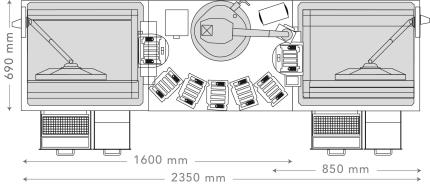Laboratory Requirements
This snippet causes dropdowns to open on page load. This text/paragraph does not appear in the output.
Use the following specifications and guidelines to determine required lab space.
The iScan
|
Measurement |
iScan |
Air Table |
Instrument Control Computer |
AutoLoader 2.x |
|---|---|---|---|---|
|
Width |
52 cm (20.5 in) |
69 cm (27 in) |
21.6 cm (8.5 in) |
85 cm (33.4 in) |
|
Height |
46 cm (18 in) |
6 cm (2 in) |
57 cm (22.3 in) |
76 cm (29.9 in) |
|
Depth |
66 cm (26 in) without keyboard tray 85 cm (33.5 in) with keyboard tray |
61 cm (24 in) |
55.4 cm (21.8 in) |
65 cm (25.5 in) |
|
Weight |
70 kg (154.3 lb) |
12 kg (26.5 lb) |
34 kg (75 lb) |
Refer to AutoLoader weight table. |
The AutoLoader 2.x has the following weight values, based on its configuration:
|
Configuration |
AutoLoader 2.x Weight Without iScan |
AutoLoader 2.x Weight With iScan |
|---|---|---|
|
Single AutoLoader 2.x (10 Carriers) |
85 kg (187.4 lb) |
155.8 kg (343.4 lb) |
|
Dual AutoLoader 2.x (20 Carriers) |
125 kg (275.6 lb) |
266.6 kg (587.8 lb) |
|
BeadChip Carrier |
0.25 kg (0.55 lb) |
0.25 kg (0.55 lb) |
A dual-scanner configuration, consisting of two iScan systems and an AutoLoader 2.x, fits on a typical lab bench. For more information, refer to Lab Bench Guidelines.
Dual-Scanner Configuration Dimensions with AutoLoader 2.x

The following requirements ensure access to the instrument power switch and power outlet, allow proper ventilation, and provide sufficient access for servicing the instrument.
| • | Allow for an additional 15.5 cm (6 in) behind the instrument. |
| • | Position the iScan so that personnel can quickly disconnect the power cord from the outlet. |
| • | Allow at least 42 cm (17 in) above the iScan loaded on the air table so that the exterior panels can be removed during installation and maintenance. The height dimension listed in the following laboratory space planning table includes this required overhead space. |
|
Measurement |
Instrument |
PC, Keyboard, and Monitor |
Air Table |
|---|---|---|---|
|
Width |
112 cm (44 in) |
46 cm (18 in) |
67 cm (27 in) |
|
Height |
94 cm (37 in) |
Lab defined |
6 cm (2 in) |
|
Depth |
101 cm (40 in) |
40 cm (16 in) |
76 cm (30 in) |
It is recommended that the bench top vibrations stay below the vibration criterion (VC)-E curve. Make sure that there are minimal disturbances or sources of vibration on or near where the iScan is installed. Use the following best practices to minimize vibrations:
| • | Do not place other equipment on the bench that can produce vibrations that exceed the VC-E curve. |
| • | Do not place objects on top of the instrument. |
| • | Keep sources of vibration away from the instrument. |
| • | Only use the keyboard and mouse to interact with the instrument during operation. |
Place the instrument on a mobile lab bench with locking casters. The lab bench surface must be level (within ± 2 degrees) and nonvibrational. The bench must support the weight of the instrument and instrument control computer.
|
Width |
Height |
Depth |
|---|---|---|
|
152.4 cm (60 in) |
76.2–91.4 cm (30–36 in) |
76.2 cm (30 in) |
If located in North America, Illumina recommends the Bench-Craft mobile bench with casters (PN HS-30-60-30 P2) or equivalent.
The iScan Reader instrument is sensitive to vibrations. Therefore, Illumina recommends using the Illumina air table (PN 222009) to help isolate the reader from vibrations produced by the surrounding environment.
If you are using the Illumina air table, place it between the reader and the laboratory benchtop. Then, connect the air table to the regulator that is connected to the house air line.
Set the air table pressure to a nominal value of 25 psi. Do not allow the air table pressure to exceed 40 psi. The maximum pressure from the house line to the air regulator is 80 psi.
If house air is unavailable, a regulated tank of CO₂ or nitrogen can be used with an output of approximately 35 psi.
